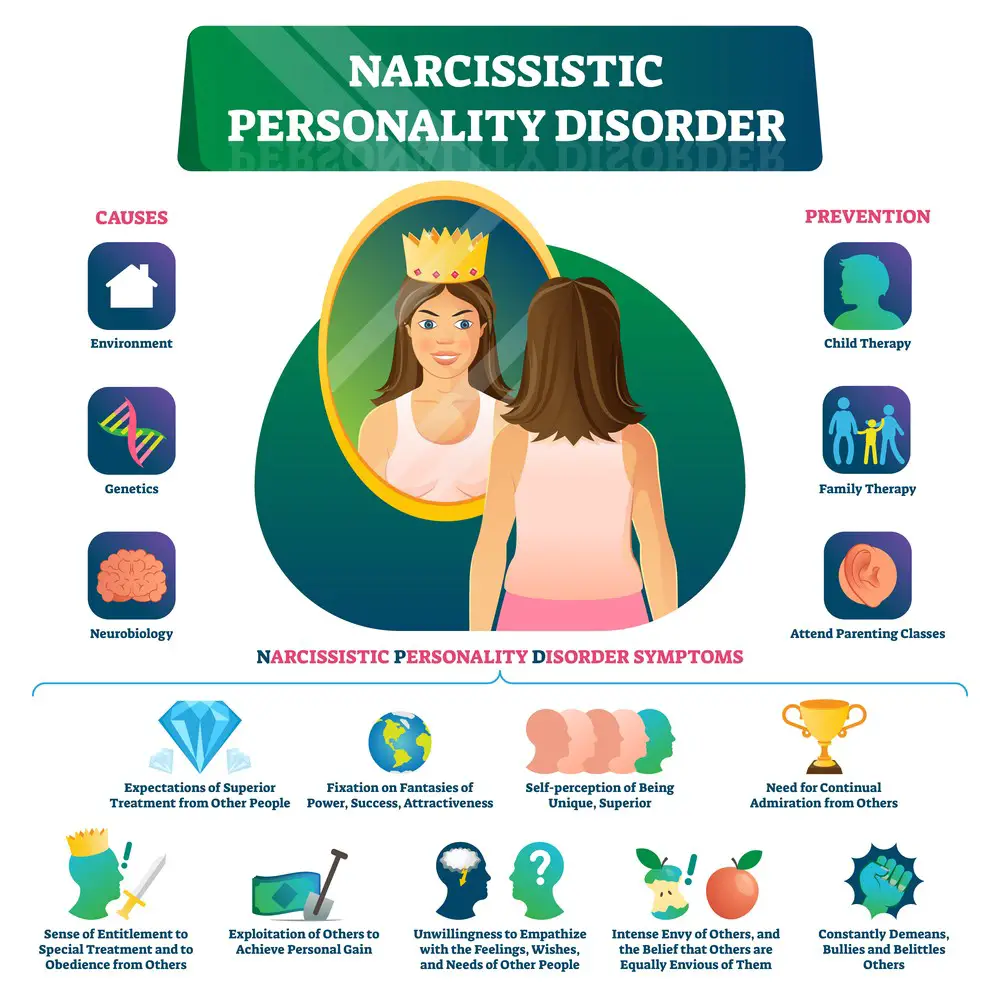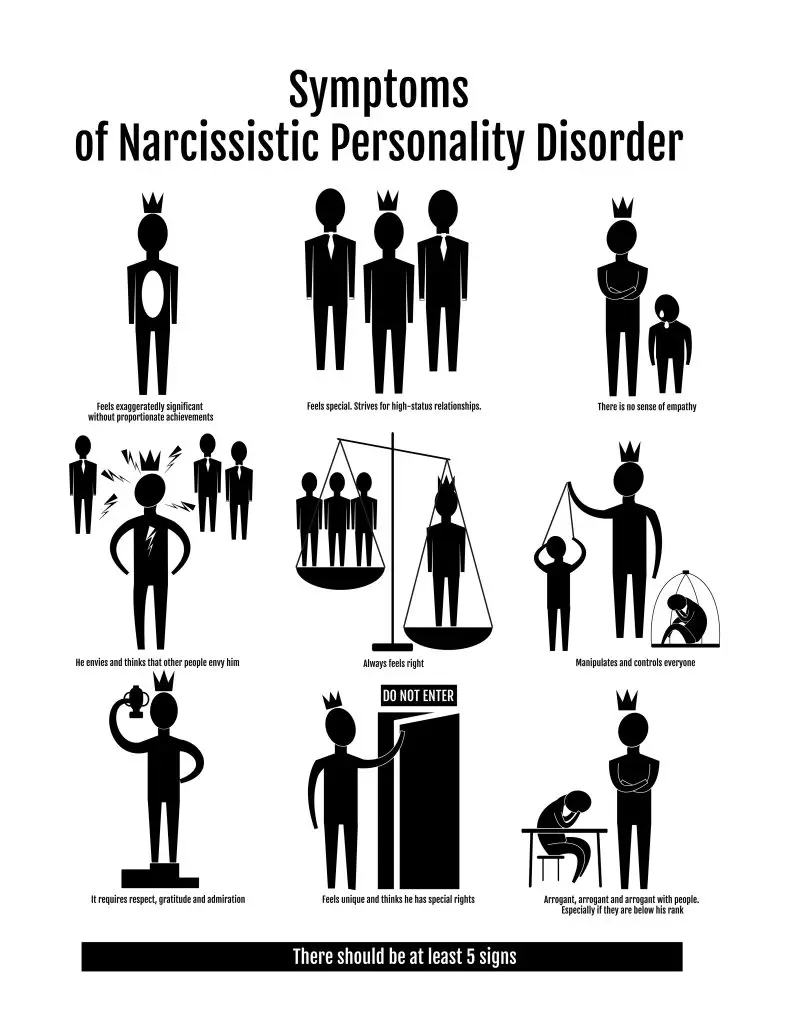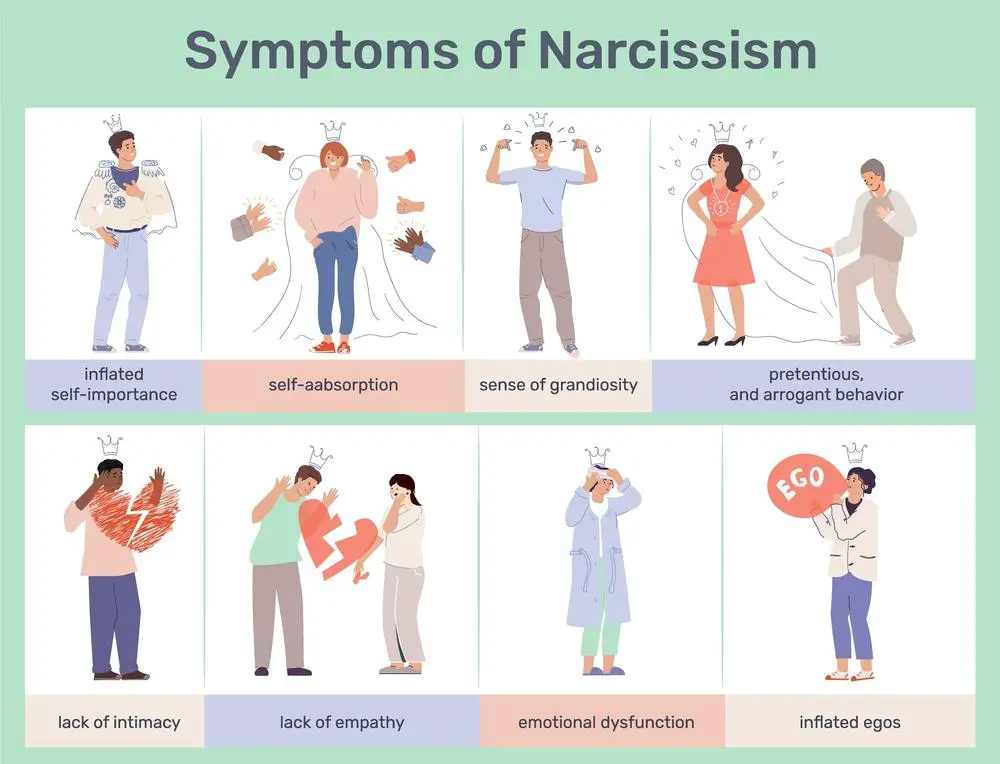As a BetterHelp affiliate, we receive compensation from BetterHelp if you purchase products or services through the links provided
Narcissism is a personality trait that spans a spectrum, often characterized by an inflated sense of self-importance and a deep need for attention and admiration. Female narcissists possess these traits and display particular behaviors that may differ from their male counterparts due to societal and cultural influences. Understanding the nuances of female narcissists can shed light on the dynamics of personal and professional relationships.
Recognizing the signs of narcissism in women can be challenging, as they sometimes exhibit these features in less overt and more socially acceptable ways. You need to be aware of the subtleties, including emotional manipulation and the guise of victimhood, which can be particularly damaging to those around you. Acknowledging and identifying these behaviors is a crucial step towards addressing and managing their impact on yourself and others.
While the conversation about narcissism often focuses on men, women too can embody narcissistic traits, affecting family, romantic relationships, and friendships. The emotional and psychological aspects can be profound, leading to a complex interplay of self-esteem issues and interpersonal conflicts. Awareness and appropriate strategies are key in setting boundaries and promoting healthy interactions with individuals displaying these characteristics.
Key Takeaways
- Female narcissists display traits such as a need for admiration and a sense of entitlement, often differently than males.
- Identifying narcissistic behaviors in women is crucial for managing personal and professional relationships affected by these traits.
- Strategies for setting boundaries can aid in mitigating the impact of female narcissism on oneself and others.
 Understanding Female Narcissism
Understanding Female Narcissism
Exploring the concept of female narcissism requires us to discern the clinical characteristics and consider the unique expression of narcissistic traits in women.
Diagnostic Criteria
Narcissistic Personality Disorder (NPD), as defined by the DSM-5, is characterized by a pervasive pattern of grandiosity, a need for admiration, and a lack of empathy. The American Psychiatric Association provides specific criteria that include:
- A grandiose sense of self-importance
- Preoccupation with fantasies of unlimited success and power
- Belief of being special and unique
- A need for excessive admiration
- A sense of entitlement
- Interpersonally exploitative behavior
- Lack of empathy
- Envy of others or belief that others are envious of them
- Arrogant and haughty behaviors or attitudes
Key Takeaway: If you question whether a behavior aligns with these criteria, consulting the DSM-5 or a mental health professional may provide clarity.
 Narcissistic Personality Disorder
Narcissistic Personality Disorder
Narcissistic Personality Disorder represents a long-term pattern of behavior that can impact various aspects of a woman’s life, including personal relationships and social interactions. NPD is diagnosed through clinical evaluation, as it requires a trained professional to consider the context and intensity of the symptoms.
- Symptoms can lead to significant impairments in personal and social functioning.
- It’s not uncommon for those with NPD to also have co-occurring psychiatric disorders.
Key Takeaway: Remember, diagnosis should only be made by qualified professionals – self-diagnosis can lead to misunderstandings and overlook complexities of one’s personality or mental health.
Narcissism in Gender Context
While narcissism occurs in both men and women, the expression of narcissistic traits might differ due to social and cultural factors. Studies suggest that:
- Male narcissists tend to display more overt aggression and entitlement.
- Female narcissists may exhibit behaviors such as subtle manipulations or using appearance to gain attention.
Being aware of these distinctions is crucial for recognizing narcissism in different contexts.
Key Takeaway: Narcissistic traits can manifest differently across genders, impacted by societal expectations and cultural conditioning.
Characteristics of Female Narcissists
When you’re dealing with female narcissists, it’s essential to understand how they view themselves and interact with others. Their behaviors often follow a pattern characterized by a high sense of self-importance, manipulative tactics, and an insatiable need for admiration.
Sense of Self-Importance
Female narcissists often display a grandiose sense of self-importance. They believe they’re unique and can only be understood by or associated with other special or high-status people or institutions.
- Belief in their superiority: They feel superior to others and expect to be recognized as such.
- Expectation of special treatment: Their worldview demands that they receive special favors and compliance with their expectations.
Key takeaway: Female narcissists carry an inflated view of their importance, expecting to be treated as superior.
Manipulation Tactics
The arsenal of a female narcissist’s manipulation is varied and often subtle.
- Uses charm or wit for personal gain: They draw you in with their charm, using it to achieve their ends.
- Exploitation: They don’t hesitate to take advantage of others, often without regard for feelings or consequences.
Key takeaway: Be mindful of the charming facade, which might conceal manipulative intentions.
Need for Admiration
A female narcissist has an excessive need for admiration and works hard to keep the spotlight on herself.
- Fishing for compliments: They might use self-deprecation to receive compliments and assurance.
- Reacts negatively to criticism: Criticism is often met with rage or contempt.
Key takeaway: Their thirst for admiration can lead to a constant search for praise, often reacting poorly to critique.
Female Narcissism in Relationships
Understanding the role of female narcissism in relationships can offer invaluable insights into the dynamics that shape romantic, family, and professional interactions. Recognizing certain behaviors and traits can guide you towards healthier connections.
Romantic Interactions
When a woman with narcissistic traits enters a romantic relationship, things can get quite complicated. You might notice an intense beginning, where she showers you with attention and admiration. This is often part of a manipulation tactic known as love bombing. Over time, the dynamic may shift dramatically, leading to patterns of domestic abuse, including intimate partner violence (IPV), as she strives to maintain control and influence over her partner.
- Key signs of manipulation:
- Excessive flattery in the beginning stages.
- Gradual control over your actions and decisions.
Key takeaway: Be mindful of the balance of give-and-take in your relationship and beware of an overabundance of flattery as it may signal manipulative intentions.
Parenting Styles
In terms of parenting, a narcissistic mother can create a complex family dynamic. You’ll often find that such individuals may struggle with empathy, making emotional connections with their children challenging. It is not uncommon for narcissistic parents to exhibit favoritism or to use children as extensions of themselves, prioritizing their needs and desires over the well-being of their children.
- Strategies for children and co-parents:
- Seek external support from therapists or family counselors.
- Build a strong network of emotional support outside of the family unit.
Key takeaway: If you’re dealing with a narcissistic parent, remember to prioritize self-care and look for support systems outside your immediate family.
 Workplace Dynamics
Workplace Dynamics
Female narcissism can become evident in the workplace as well. Such an individual may appear charming and capable, initially drawing in co-workers and superiors. However, behind this façade, you might encounter manipulative behaviors to advance your status or undermine others. Don’t be surprised if such individuals take credit for your work or display a lack of team spirit.
- Coping strategies in the workplace:
- Document your contributions and communicate them during reviews.
- Build a diverse network within your work environment to reduce the impact of one person’s negative behavior.
Key takeaway: Keep a record of your work achievements and establish strong connections with other team members to protect your professional interests.
The Impact on Self and Others
When you interact with a female narcissist, you may notice the complex effects on both her sense of self and the well-being of those around her.
Sense of Superiority
A female narcissist often carries an inflated sense of self-worth and superiority. This belief that she is somehow better than others can lead her to demand special favors and expect preferential treatment. Here’s what you might see:
- Expectations: Consistent demand for attention and admiration.
- Behaviors: Positioning herself above others, regardless of context or appropriateness.
Key Takeaway: You’re not imagining it—such entitlement is a hallmark of narcissistic personality.
Lack of Empathy
You’ll notice that empathy, the ability to understand and share the feelings of another, is typically missing in the behavior of a female narcissist. Her inability to connect with others’ emotions can manifest in various ways:
- Interactions: She may disregard others’ feelings or experiences.
- Consequences: Relationships often suffer due to this lack of emotional give-and-take.
Key Takeaway: Remember, your feelings are valid, even if a narcissist does not acknowledge them.
Impact on Children
Children under the care of a narcissistic mother can face unique challenges. The impact on their development and self-worth can be significant:
- Control: A tendency to micromanage children’s lives, often to reflect positively on herself.
- Modeling Empathy: Children may struggle to learn empathy if not modeled by the parent.
Key Takeaway: Children must have a balanced environment to foster healthy emotional growth.
Emotional and Psychological Aspects
Exploring emotional and psychological aspects is crucial to understanding how female narcissists may experience and exhibit certain behaviors. These inner experiences often manifest in ways that can be disruptive both to the narcissists themselves and to those with whom they interact.
Insecurity and Shame
You might find that beneath a female narcissist’s grandiose demeanor lies a core of insecurity. Psychological studies suggest that a profound sense of inadequacy often fuels their need for admiration. Shame, although deeply hidden, can drive much of their actions and attitudes:
- Insecurity: It often presents as a relentless drive for perfection to shore up fragile self-esteem.
- Shame: When triggered, shame can lead to an outward display of contempt or disdain as a defense mechanism to protect the fragile ego.
Key Takeaway: Recognize that insecurity and shame in female narcissists are like an iceberg; what’s visible on the surface is only a small indication of the vast emotional complexities underneath.
Rage and Aggression
When a female narcissist feels threatened or slighted, intense emotions such as rage may erupt. This anger can escalate rapidly and often catches others off-guard:
- Rage: You may observe sudden outbursts over perceived criticisms, often disproportionate to the situation.
- Aggression: This can manifest in both verbal and psychological forms, aiming to control or intimidate others.
Key Takeaway: Consider that a narcissist’s sudden rage isn’t just anger; it’s a response mechanism to defend against feelings of vulnerability.
Low Self-Esteem
Despite appearances, female narcissists frequently grapple with low self-esteem. This is like a shadow that follows them, influencing numerous aspects of their behavior:
- Hidden Doubts: Corners of their psyche may be plagued by feelings of unworthiness or a fear of being unlovable.
- Emotional Turmoil: They may react with hypersensitivity to judgment or failure, contributing to anxiety and, potentially, depression.
Key Takeaway: Remember, the seemingly confident exterior often masks a deep-seated feeling of inadequacy that can profoundly impact a female narcissist’s emotional state.
 Identifying Narcissistic Behaviors
Identifying Narcissistic Behaviors
When interacting with a female who may display narcissistic tendencies, it’s crucial to recognize specific behaviors that often accompany this condition. Being aware of these patterns helps you understand and navigate any encounters you may have.
Gaslighting and Lies
Gaslighting is a form of manipulation where the narcissist makes you doubt your own reality and memories. Here’s how you might identify gaslighting:
- Confusion: They’ll insist events didn’t happen as you remember.
- Doubt: You’ll frequently hear that you’re too sensitive or misremembering things.
Lies can range from subtle distortions to outright falsehoods. Be skeptical if you notice:
- Inconsistencies: Their stories change over time.
- Evidence: Your own experience doesn’t match what you’re told.
Key Takeaway: Trust your instincts if your memory of events is constantly challenged or stories don’t align with the facts.
 Jealousy and Competition
Jealousy and Competition
If you’re dealing with jealousy and competition, some signs would be:
- Comparisons: You’ll hear about her being better than others in every conceivable way.
- Disparagement: Your successes might be diminished or criticized.
Jealous behavior might not always be overt, so keep an eye out for:
- Backhanded compliments: Praise that isn’t quite praise.
- Coldness: A shift in attitude when you achieve something good.
Key Takeaway: Notice when compliments sting or your good news isn’t shared in the joy it deserves.
Passive-Aggressive Behaviors
Passive-aggression is a hallmark of female narcissism, with these behaviors being common:
- Sarcasm: Veiled sarcasm instead of direct communication.
- Silent treatment: Withdrawing communication to express dissatisfaction.
In social settings, you may observe:
- Gossip: Spreading unflattering rumors about someone indirectly.
- Exclusion: You might find yourself subtly left out of plans.
Key Takeaway: Passive-aggressive hints and social exclusion can be indicative of underlying narcissistic traits.
The Role of Culture and Society
Culture and society significantly shape the expression and perception of narcissistic behaviors, particularly in females.
Media Influence
In today’s society, the media often portrays success and power as directly linked to physical appearance. This portrayal can influence female narcissists in two primary ways:
- Self-image Focus: For some women, this creates intense pressure to maintain an idealized image, where external validation becomes a priority over personal achievements.
- Status and Worth: There’s an emphasis on appearances as a measure of worth, leading some to equate looking successful with being successful, which feeds into narcissistic tendencies like pride and a desire for admiration.
Key Takeaway: Media shapes the value placed on appearance and status, directly affecting self-perception and behaviors in female narcissists.
Social Expectations
Social expectations can heavily influence how female narcissists perceive themselves and interact with others. Consider these aspects:
- Gender Roles: Society often has double standards that expect women to be nurturing and self-effacing yet simultaneously celebrate assertiveness in pursuing success. This dichotomy can confuse and exacerbate narcissistic traits in women seeking power.
- Peer Comparisons: Comparison with peers, whether in personal achievements or physical attractiveness, can fuel competitiveness. This competition often leads to an increase in narcissistic behavior as a defense mechanism or a strategy to ascend socially.
Key Takeaway: Social expectations can drive female narcissists to adopt certain behaviors to align with or rebel against gender-specific norms.
 Approaches to Therapy and Healing
Approaches to Therapy and Healing
When addressing the complexities of female narcissism, therapy and healing are paramount. Effective treatments are tailored to help you reclaim your self-esteem and nurture self-love.
Cognitive Behavioral Therapy
Cognitive Behavioral Therapy (CBT) focuses on changing the negative thought patterns that often accompany narcissism. Your therapist will work with you to help alter these patterns and behavior.
- Identify Distorted Beliefs: Recognize the beliefs fueling narcissistic behavior.
- Challenge Thoughts: Learn to challenge and replace them with healthier ones.
- Behavioral Techniques: Employ techniques to improve interactions with others.
Key Takeaway: CBT aims to rewire your thoughts to foster better relationships and self-awareness.
Group Therapy
Group therapy provides a support system where you can connect with others facing similar challenges.
- Shared Experiences: Realize you’re not alone in your journey.
- Feedback and Insight: Gain diverse perspectives to enhance personal growth.
- Building Empathy: Develop empathy by understanding other’s feelings and experiences.
Key Takeaway: Group therapy helps you learn from others and offers a mirror to reflect on your own behavior.
Self-Help Strategies
Engaging in self-help strategies can complement formal therapies and support your treatment journey.
- Self-Reflection: Regularly take time to reflect on your emotions and actions.
- Set Boundaries: Learn to set healthy boundaries to respect yourself and others.
- Affirmations and Self-Care: Incorporate positive affirmations and self-care into your daily routine to bolster self-love.
Key Takeaway: Self-help strategies empower you to take charge of your healing and build a stronger sense of self.
Setting Boundaries and Recovery
In the journey to heal from the impact of a relationship with a female narcissist, setting clear boundaries and rebuilding self-esteem are crucial steps. They pave the road to recovery and empowerment after a problematic chapter.
Establishing Boundaries
Knowing where to draw the line with others can protect you from further emotional harm. Let’s talk about how you can do just that:
- Be clear about your limits. Write down the behaviors you won’t tolerate, and communicate them assertively to ensure no ambiguity.
- Stick to your boundaries. Once set, keep firm, even if you face resistance or attempts to cross these limits.
- Seek support. If maintaining boundaries becomes tough, tap into your support network or consider professional help.
Pro Tip: If someone continually disrespects your boundaries, minimizing or ending contact with them may be necessary for your well-being.
Rebuilding Self-Esteem
After experiencing the brunt of selfish behavior, rebuilding your sense of self-worth is vital:
- Recognize your value. Begin by listing your strengths and accomplishments. Remind yourself of these qualities daily.
- Stay kind to yourself. Engage in self-care and positive self-talk. You’re your most important ally.
- Reject negativity. Dismiss negative thoughts about yourself, especially those seeded by the narcissistic individual.
Key Takeaway: Taking small daily steps to appreciate and affirm yourself will slowly restore your self-esteem.
If you ever feel overwhelmed, the National Domestic Violence Hotline offers confidential help and can guide you to resources for recovery. Remember, you’re not alone; with time and effort, you can heal and flourish again.
Research, Theories, and Models
Exploring the realm of female narcissism requires understanding the evolution of thought and the latest scientific inquiries into the subject. Engaging with these ideas can offer you a comprehensive view of the intricate psychological landscape.
Historical Perspectives
The journey into female narcissism began with the early works of Sigmund Freud. Freud postulated that narcissism stemmed from an early stage in human psychological development. His theories laid the foundations for later psychologists to build upon, although his gender-focused assumptions have been critiqued over time.
- Freudian Theory: Freud suggested that both males and females pass through phases of narcissism, but they manifest differently based on gender norms and roles.
Recent Studies
More contemporary research has enhanced our understanding using advanced methods like item response theory, which assesses the various dimensions of personality disorders, including narcissism. A standout in this field is the meta-analytic review published in Psychological Bulletin, which collates numerous studies to give a balanced view.
Emerging Trends:
- Recent studies have utilized complex statistical techniques to pinpoint potential causes and aetiology of female narcissism.
- A shift towards gender-neutral approaches in research is noted, examining traits rather than gender-based assumptions.
Key Takeaways:
- Female narcissism is increasingly seen as a construct influenced by a wide array of factors, not just confined to gender.
- Modern research leverages robust methodologies for a nuanced understanding of the condition.
Frequently Asked Questions
In this section, you’ll find insightful responses to common inquiries about the behaviors and patterns displayed by women with narcissistic traits, especially within relationships. Each answer will give you a better understanding of such complex interactions.
What are common behaviors displayed by women with narcissistic traits in a relationship?
Women with narcissistic traits may often exhibit a lack of empathy and be overly concerned with themselves. They might also demand constant admiration and have an inflated sense of their importance. In relationships, these traits can translate to manipulative behaviors where their needs always come first.
Key takeaway: If your partner consistently places their needs above yours and lacks empathy, these could be signs of narcissistic traits.
How might a woman with narcissistic tendencies employ gaslighting tactics?
Gaslighting is a manipulation technique used to make someone question their reality. A woman with narcissistic tendencies might deny things she’s said or done or belittle your feelings, claiming you’re too sensitive. This can lead to confusion and self-doubt in the victim.
Key takeaway: Trust your instincts; gaslighting could be at play if you feel continually undermined and confused.
What patterns of behavior can you expect from a woman with narcissistic personality disorder when she starts to lose control in a relationship?
When a woman with narcissistic personality disorder senses losing control, she may become particularly defensive or aggressive. She might create drama to reassert her dominance or disparage you to regain the upper hand.
Key takeaway: Be aware of sudden shifts towards defensiveness or hostility, as they can indicate a struggle for control.
How might a woman with narcissistic tendencies react when confronted with a lack of attention or indifference?
A lack of attention can trigger intense reactions from a woman with narcissistic tendencies. She might engage in attention-seeking behaviors, act out dramatically, or even punish the perceived source of neglect to reestablish a sense of superiority and reassurance.
Key takeaway: If there’s an over-the-top reaction to perceived neglect, narcissism could possibly be influencing the behavior.
What are some warning signs that may indicate you are dealing with a narcissistic female partner?
Warning signs to look out for include a constant need for admiration, sensitivity to criticism, and a propensity to manipulate or exploit relationship dynamics for personal gain. Additionally, she may have an exaggerated sense of entitlement and a willingness to demean others to maintain a sense of superiority.
Key takeaway: If these warning signs feel familiar in your relationship, consider them red flags.
How do narcissistic women typically treat their significant others over the course of a relationship?
Over time, a narcissistic partner might oscillate between periods of idealization and devaluation. Initially, they may shower you with affection, only to later withdraw it and make you feel unworthy. Their treatment of you often depends on how well you cater to their emotional needs or feed their ego.
Key takeaway: Inconsistent treatment and emotional highs and lows can indicate a cycle of idealization and devaluation typical in such relationships.
Blog Post Bio: Jacob Maslow
About Me: Jacob Maslow – Mental Health Advocate & Writer
Hello, I’m Jacob Maslow, and I’ve walked a path filled with complex emotional landscapes. Here’s a glimpse into my journey:
- Mental Health Warrior: Battling my mental health challenges, I’ve found solace and strength in taking Lexapro, which helps me manage my daily mental health effectively.
- Therapy Journeyman: I’m no stranger to therapy. I’ve been a therapy veteran for a while now, and recently, I’ve joined BetterHelp to continue my journey toward mental wellness.
Personal Struggles: Navigating Difficult Waters
My personal life has been a testament to resilience in the face of adversity:
- Family Dynamics: My ex-wife’s actions have dramatically impacted our family post-divorce. Her refusal to cooperate with court-ordered shared custody and her complete alienation of our children have been challenging.
- Coping Mechanism: I take long walks daily to find peace and clarity. It’s my way of clearing my head and staying grounded amidst the turmoil.
✍️ My Writing: Shedding Light on Narcissism and Mental Health
Through my experiences, I’ve become a passionate writer, focusing on:
- Narcissistic Behavior Insight: Having dealt with a narcissistic partner, I share insights about their behaviors, like chasing after community leaders and conducting smear campaigns.
- Mental Health Advocacy: I aim to help those dealing with mental health challenges and those struggling with narcissistic partners. I firmly believe that anyone can overcome their mental health issues.
Legal Assistance: Offering a Helping Hand
I’m also deeply involved in providing legal guidance through my website:
- Navigating Legal Challenges: I support others facing non-compliant spouses, especially in matters of custody and co-parenting.
- From Experience to Expertise: Utilizing my personal experiences, I provide practical advice and legal solutions to those in similar situations.
Moving Forward: Embracing Hope and Healing
- Staying Connected: Despite the challenges, I maintain a strong bond with my children and continue to fight for our relationship.
- Continued Advocacy: Every article I write, and advice I share is a step towards helping others find their path to healing and mental wellbeing.
Join me on this journey of discovery, healing, and empowerment.
- Stress Management: What is the Relationship Between Stress and Addiction? - June 28, 2024
- Exploring Techniques to Maintain a Healthy Lifestyle without Drugs - May 28, 2024
- How Acupuncture Helps Treat Chronic Fatigue Syndrome - May 28, 2024
This site contains affiliate links to products. We will receive a commission for purchases made through these links.


 Understanding Female Narcissism
Understanding Female Narcissism Narcissistic Personality Disorder
Narcissistic Personality Disorder
 Workplace Dynamics
Workplace Dynamics Identifying Narcissistic Behaviors
Identifying Narcissistic Behaviors Jealousy and Competition
Jealousy and Competition Approaches to Therapy and Healing
Approaches to Therapy and Healing


